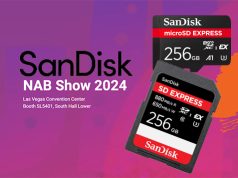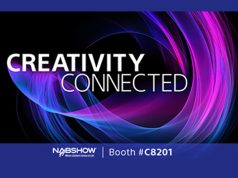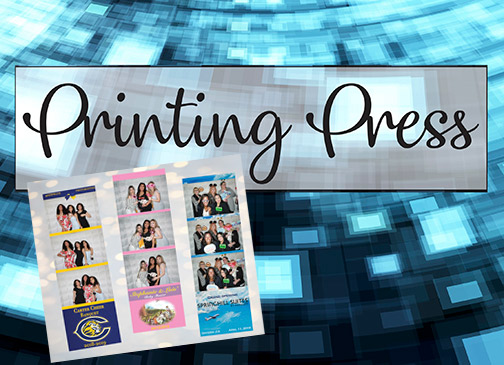
Photo booth imaging has found a new following among millennial buyers—76 million influential consumers who are contributing to recent surges in photo print sales. Both stationary and portable photo booths are increasingly visible at amusement parks and shopping malls, where they were familiar fixtures in the mid to late 20th century.
Today, curtained booths are also found in family restaurants, bars, art galleries and other locations where consumers like to document and share their experiences via social media. Moreover, portable photo booths and event photography services are commonplace attractions at weddings, birthday parties and corporate events.
FOMO & Photo Booth Imaging
Ana Gotter, a writer for the marketing website AdEspresso, attributes the surge in photo booth popularity in part to FOMO, or the “Fear of Missing Out” on events and social activities.
“With increasing amounts of our lives being shared across social media, people are more afraid than ever of missing out on something amazing,” she writes. “FOMO is a potent force, particularly in millennials, who currently make up a huge portion of buying power; one study states that a whopping 69% of millennials feel a fear of missing out when they can’t attend some sort of event. This applies to users of all age groups.”
According to Gotter, FOMO frequently drives consumers to buy products, participate in events as well as share their experiences on social media. This is all in an effort to keep up with popular trends and gatherings.
Retailers, corporations and family entertainment centers tap into this urge in order to generate interest in their products. For example, parents buy a picture of their kids at a Chuck E. Cheese pizzeria-branded photo booth and share it on social media; it’s a highly effective marketing campaign that costs relatively little to implement. Corporate and social events, such as product launches, sporting events and weddings, are more likely to employ portable photo booth setups manned by operators who supply props and costumes to enhance the picture-taking experience.
Photo Booth Printer Options
Mitsubishi Electric Visual and Imaging Systems
James Chan, director of Marketing and Business Planning for Mitsubishi Electric Visual and Imaging Systems, in Cypress, California, notes that coin-operated photo booths are on the upswing in arcades and entertainment centers.
“Unmanned booths are actually one of our biggest customer bases,” Chan says. “Some are like the old-fashioned booths with curtains; others can accommodate larger groups for photos. They are set up much like our mobile phone or tablet cameras, with one camera on the inside and one on the outside of the booth.”
Chuck E. Cheese photo booths feature an inside/outside camera design; they currently use Mitsubishi CP-9550DW dye-sublimation photo printers to output customers’ prints.
CP-M1A
In addition, Mitsubishi recently introduced a successor to the 9550DW and 9810DW—the high-capacity, high-speed, CP-M1A. It is designed primarily for photo booth integration, amusement parks, event and entertainment photography, as well as mass retail and kiosk photofinishing. The CP-M1A measures 11.8×13.8×11.1 inches and weighs approximately 31 pounds.
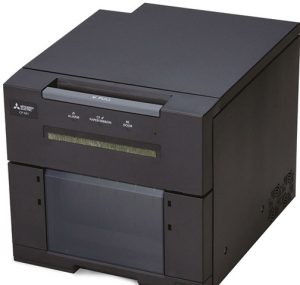
“In my opinion, the M1A is the best printer Mitsubishi has ever released,” says Chan. It is a high-capacity printer that not only qualifies as best in image output quality but also features the fastest reload speed and operational simplicity, compared to competing professional photo booth printers.
“All of these features are of particular benefit to M1A’s largest target audience of photo booth and coin-operated self-operating booth providers,” he adds. “These companies typically have a high field staff turnover, which includes unskilled operators hired to change printing media at their photo booth locations every one or two weeks.
“We made sure the mechanics of the design were catered toward simplicity of replacing the media. You only have to remove the printer cover, pull out the expended cartridges, drop in the new media and close. You don’t have to roll and unroll paper or insert flanges. Everything is geared toward increasing efficiency and making it easy for printer operators to use.”
What’s more, each box of M1A replacement media comes with a single roll of paper and a dye-sub printer cartridge, capable of outputting up to 750 4×6-inch prints. The M1A is also capable of printing 5×7-inch photographs in full bleed—a popular size in the event photography industry—and 6×8-inch images.
Fujifilm North America
Fujifilm, located in Valhalla, New York, will introduce a new photo booth printer in the first quarter of 2020. The ASK-500 dye-sublimation printer will be an upgrade to the current ASK-300 model. It will provide more efficient reloading capabilities, improved image quality as well as easier paper and ribbon loading than the ASK-300.
“Fujifilm currently offers two printers for the photo booth industry,” says Steven Vallario, Fujifilm’s director of product management, Hardware Solutions. “The ASK-300 dye-sublimation printer and Frontier-S DX100 compact dry lab.”
The ASK-300 is more often used in photo booths because of its compact size and relative ease of use. The Frontier-S DX-100 dry lab is an inkjet printer that is slightly larger than its dye-sublimation competitors.

“They’re both excellent printers and they’re both great for the event market; although there are certain advantages with one over the other,” he adds. “The DX100 is used in certain photo booth configurations because of its excellent print quality and enhanced versatility in terms of print sizes and products. For example, we have photo booth integrators who use it to print very large photo booth strips, or jumbo panoramic strips as large as 8×39 inches.”
Fujifilm ASK-500
The improved ASK-500 dye-sublimation printer will have the same footprint, weight and print sizes as the ASK-300; it measures 10.8×17.6×6.7 inches, weighs 26.4 pounds and provides output sizes of 2×6-, 3.5×5-, 4×6-, 5×7- and 6×8-inches. Additional product details and enhancements will be available with the official launch in 2020.
Fujifilm’s Frontier-S DX100 measures 18.1×16.9×13.9 inches and weighs 51 pounds. Roll paper for the DX100 inkjet printer is available in 4-, 5-, 6- and 8-inch widths, with each roll capable of printing multiple print sizes. The 6-inch wide paper is used to print images from 4×6 to 6×6 inches, as well as 6×20 panoramic prints. The DX100 is also capable of printing 8×10- and 8×12-inch prints, as well as banners up to 8×39 inches.
Sinfonia Photo
Headquartered in Somerset, New Jersey, Sinfonia Photo offers three dye-sublimation printers for the photo booth market. They are the Sinfonia CS2, CE1 and S3 photo printers.
The CS2 (originally the Shinko Color Stream CS2) is one of the smallest and lightest photo printers on the market; it measures 11x13x7 inches and weighs 22 pounds. The 6-inch compact printer is capable of producing 4×6-inch prints in less than 11 seconds.
The Sinfonia CE1 is an 8-inch compact printer that is capable of outputting 8×8-, 8×10- and 8×12-inch prints in about 30 seconds. It measures 13x16x7 inches and weighs about 30 pounds with media loaded.
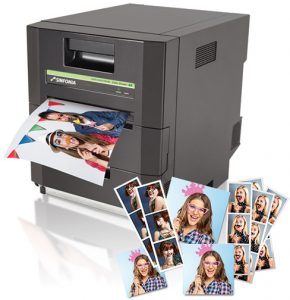
Lastly, the Sinfonia S3 high-capacity digital photo printer is the next generation of Sinfonia’s CHC-S2145 digital photo printer and the company’s newest dye-sublimation model. The S3 measures 11.4×14.7×13.6 inches and weighs 33 pounds (with media). The S3 is capable of producing 4×6-, 6×6-, 5×7- and 6×8-inch prints. It also produces 2×6-inch photo strips.
DNP IAM
DNP Imagingcomm America Corporation, located in Concord, North Carolina, offers a complete line of dye-sublimation printers for on-site event photography, photo booths and amusement park attractions.
The company’s flagship printer, the DS620A, measures 10.8×14.4×6.7 inches and weighs approximately 26 pounds. It is capable of producing 2×6-inch photo strips and up to 6×8-inch prints, including 5×5- and 6×6-inch square prints. It also prints 6×14- and 6×20-inch panoramic photos.
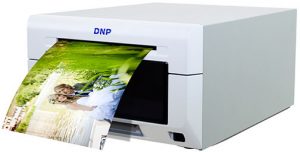
In addition, DNP offers the DS-RX1HS, which provides 2×6-, 4×6-, 6×6- and 6×8-inch prints. Moreover, the company’s DNP DS820A printer can handle multiple print sizes from 8×4 to 8×12 inches; it also features the latest generation thermal heads.
Further, DNP will announce a new printer at the Imaging USA trade show, January 19–21, 2020.
Hi-Touch Imaging
With U.S. offices in Walnut, California, Hi-Touch Imaging Technologies, Inc., offers three dye-sublimation printers for photo booth applications as well as on-location event photography.
The HiTi P525L is a compact photo printer measuring 12.9×11.8×14.1 inches and weighing just under 40 pounds. It accommodates five print kits (two of them serrated), with print sizes from 1.3×6 to 6×8 inches. The P525L is also the first photo printer to use radio frequency identification (RFID) technology to recognize the RFID media chips for easier media changes.
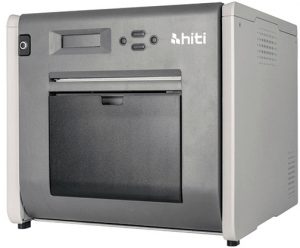
In addition, the HiTi M610 roll-type printer features a new eco-friendly paper formula without toluene. It also utilizes an improved engine technology that promises outstanding performance with consistent print quality. Its print sizes range from 2×6 to 6×8 inches, with two kits offering perforated paper. The front-loading M610 measures 11.4×13.8×14.8 inches and weighs just 33 pounds.
Moreover, for photo booths that require larger prints, the HiTi P910L photo printer outputs prints from 4×4 to 8×12 inches. Its compact casing measures 13×6.9×15.6 inches and weighs just under 30 pounds.



